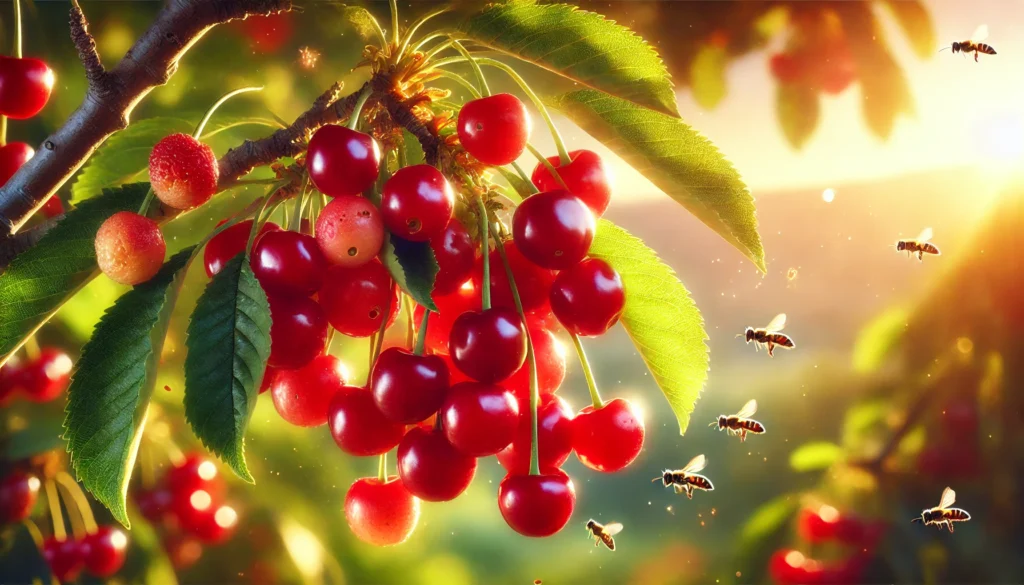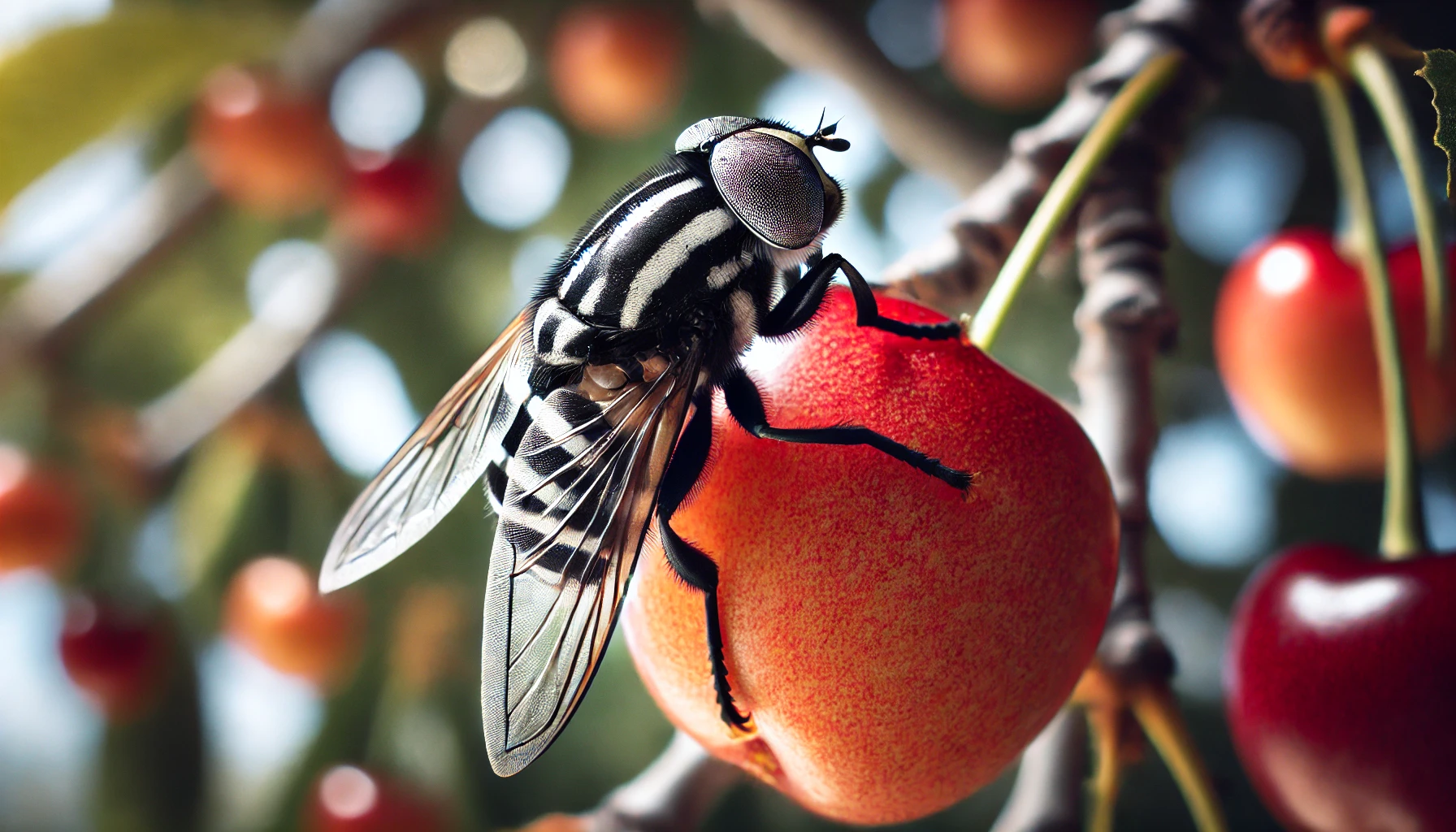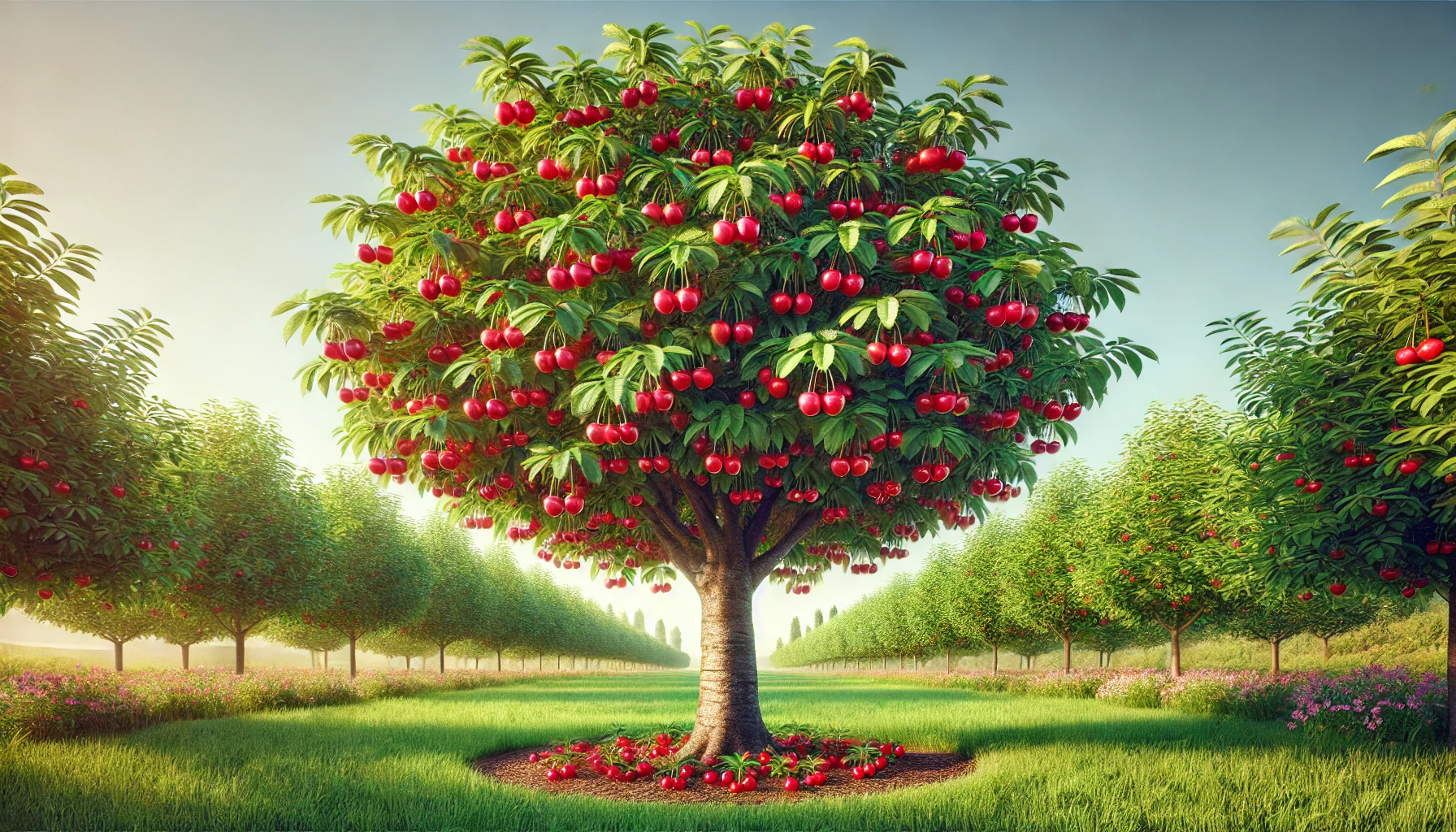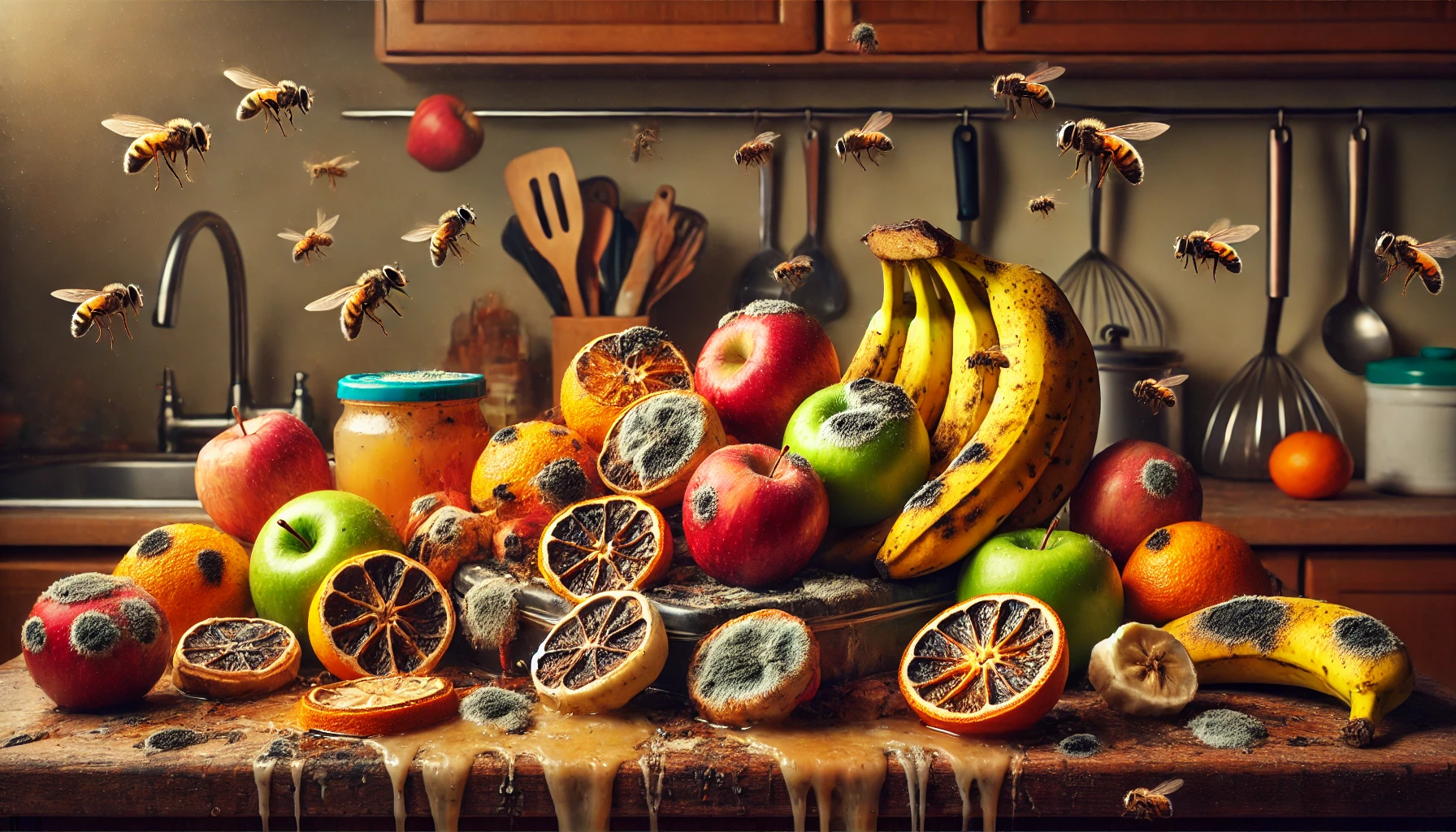
How to Deal with Cherry Tree Fruit Fly Infestations: Effective Solutions
If you’ve noticed your cherry tree’s fruit beginning to rot or become riddled with tiny holes, chances are you’re dealing with a fruit fly infestation. These pesky insects can quickly ruin your harvest and harm the health of your tree. In this guide, we’ll show you how to deal with cherry tree fruit fly infestations using effective and natural solutions that not only protect your fruit but also ensure the long-term health of your tree. Whether you’re a seasoned gardener or a beginner, this article will provide you with the knowledge you need to take action against these invasive pests.
Table of Contents
ToggleWhat Are Cherry Tree Fruit Flies? 

Cherry tree fruit flies, also known as cherry fruit fly (Rhagoletis cingulata), are tiny pests that cause significant damage to cherry trees. These small, unassuming flies are typically about 1/4 inch (6mm) long, with a distinctive black-and-white striped pattern on their bodies.




By understanding the behavior of cherry tree fruit flies, you can take steps to prevent or manage their damage effectively, keeping your cherry tree healthy and your fruit safe.
Signs of a Fruit Fly Infestation on Your Cherry Tree 

Fruit flies can quickly become a nuisance to your cherry tree, causing damage to the fruit and affecting the overall health of the tree. Here’s how to spot the signs of a fruit fly infestation early:
1. Small Holes in the Fruit 
Look for tiny puncture marks on the surface of your cherries. These holes are typically where fruit flies have laid their eggs. As the larvae hatch, they feed on the fruit, causing it to rot.

2. Rotting or Soft Fruit 
If you notice cherries that are suddenly soft, discolored, or overripe, it may be a sign of fruit fly larvae feeding inside. The damage causes fruit to decay faster than usual.
3. Maggots Inside the Fruit 
Inspect damaged fruit for small white maggots. These are the larvae of fruit flies, which can be found inside fruit that appears bruised or rotting.
4. Visible Fruit Flies Around the Tree 
During warm weather, fruit flies are often seen buzzing around the cherry tree, especially in the late afternoon. Their presence is a clear indicator of an infestation.
5. Sticky Substance on Leaves 
Fruit fly larvae often leave a sticky residue on tree leaves and branches, caused by the sap they excrete. If you notice this, it’s a sign that the tree may be affected.
6. Wilting or Drooping Leaves 
As fruit flies damage the fruit, the overall tree health can suffer. If the tree shows signs of wilting or drooping leaves, it could be from stress caused by the infestation.
Keep a close eye on these signs to catch a fruit fly problem early. The sooner you identify an infestation, the easier it is to manage and protect your cherry tree.
Preventing Cherry Tree Fruit Fly Infestations 

Cherry tree fruit flies can be a major headache for gardeners, but with a proactive approach, you can keep your trees safe. Here’s how:
- Inspect Your Trees Regularly
Early detection is key. Check your cherry trees for signs of fruit fly activity, such as small punctures on the fruit. The earlier you spot the problem, the easier it will be to manage. - Use Yellow Sticky Traps
Hang yellow sticky traps near your trees. These attract and capture adult fruit flies, reducing their population before they can lay eggs. - Maintain Tree Health
Healthy trees are less susceptible to pests. Ensure your cherry trees get enough water, nutrients, and sunlight to strengthen their natural defenses. - Prune and Remove Overripe Fruit
Fallen or overripe fruit can attract fruit flies. Regularly clean up your trees and remove any fruit that’s past its prime. - Apply Organic Pesticides
Consider using organic sprays like neem oil or insecticidal soap. These are safe for your trees and effective in controlling fruit fly larvae. - Cover Your Trees with Netting
Protective netting can physically block fruit flies from laying eggs on your cherries. Ensure the netting is fine enough to prevent even the smallest flies from getting through.
By combining these simple strategies, you can reduce the risk of fruit fly infestations and enjoy healthy, thriving cherry trees!
Effective Solutions for Dealing with Cherry Tree Fruit Fly Infestations 

Dealing with cherry tree fruit fly infestations can be frustrating, but with the right approach, you can protect your harvest and keep your trees healthy. Here’s how to tackle the issue effectively:
- Monitor for Early Signs
Keep an eye out for small puncture marks on the fruit or distorted cherries. These are often signs that fruit flies have started laying eggs. Regularly check your tree to catch the infestation early. - Use Fruit Fly Traps
Hang sticky traps around your cherry tree to catch adult flies. These traps are available in garden centers or can be made at home with simple ingredients like apple cider vinegar or overripe fruit. They help reduce the adult population and prevent more eggs from being laid. - Remove and Dispose of Affected Fruit
If you notice fruit with larvae or damage, promptly remove and dispose of it. This prevents the larvae from maturing and causing further damage to the tree. - Apply Organic Insecticides
Neem oil or insecticidal soap can be effective against fruit fly larvae. Spray your tree, especially on the underside of leaves and near the fruit, to disrupt the fly’s lifecycle. Be sure to follow the instructions to protect beneficial insects. - Implement Soil Treatments
Fruit fly larvae often overwinter in the soil. Apply beneficial nematodes to the soil around your cherry tree. These microscopic organisms target and kill larvae before they have a chance to emerge next season. - Create a Protective Barrier
Consider using a fine mesh netting around your tree to physically block fruit flies from accessing your cherries. This is a simple and effective way to keep pests away during the critical ripening period.
By following these practical and proven solutions, you can safeguard your cherry tree from fruit fly damage and ensure a healthy, bountiful harvest.
When to Act: Timing is Crucial 

Timing plays a pivotal role in the success of growing a healthy Tomatillo plant. Whether you’re planting, watering, or harvesting, knowing the right moment to take action can make all the difference.
- Planting Time
The best time to plant Tomatillos is after the last frost date in your region. Aim for spring, once the soil has warmed up to at least 60°F (15°C). Planting too early can stunt growth due to cold soil, while waiting too long might shorten your growing season. - Watering Schedule
Water your Tomatillos early in the morning to prevent disease and ensure they have enough moisture throughout the day. Be careful not to overwater; the soil should stay moist but not soggy. Adjust your watering schedule based on rainfall—during dry spells, they may need extra hydration. - Harvest Time
Tomatillos are ready for harvest when their husks turn dry and papery, and the fruit inside feels firm. This usually happens about 75-100 days after planting. Pick them before they start to split open in the husk for the best flavor and texture. - Pruning and Maintenance
Prune your Tomatillo plant in early summer to encourage better airflow and more fruit production. Removing dead or yellowing leaves can help reduce the risk of disease and ensure the plant focuses its energy on growing healthy fruit.
By understanding the timing of these key steps, you can maximize your plant’s health and harvest potential!
Post-Invasion Care: Ensuring Long-Term Health 

After successfully dealing with pests or invasive plants, it’s crucial to focus on the recovery and long-term health of your garden. Follow these key steps to ensure your plants thrive:
- Assess Soil Health
Test your soil to ensure it’s nutrient-rich and well-drained. Add organic compost or fertilizers if needed to replenish lost nutrients. Healthy soil supports healthy plants! - Watering Right
Ensure your plants receive consistent moisture, but avoid overwatering. Deep watering is better than shallow watering, as it encourages strong root systems. - Prune and Trim
Remove any dead or damaged branches to encourage new growth. Regular pruning helps maintain plant health and promotes airflow, reducing the risk of future infestations. - Mulch for Protection
Apply a layer of mulch around your plants. It helps retain moisture, keeps the soil cool, and prevents weed growth. Organic mulch also enriches the soil as it decomposes.
- Monitor for Recurrence
Keep an eye on your plants for signs of new pests or invasive species. Early detection allows for quick action and prevents another invasion from taking hold. - Fertilize Regularly
Use a balanced fertilizer to provide essential nutrients. Be sure to follow the recommended application rates to avoid over-fertilization, which can harm your plants.
By following these simple yet effective steps, your garden will stay strong, healthy, and resilient for the long term!
Common Mistakes to Avoid When Dealing with Fruit Flies 
Dealing with fruit flies can be frustrating, but avoiding these common mistakes will make your battle easier. Here’s what to watch out for:
1. Ignoring the Source of Attraction 
Fruit flies are attracted to ripened or decaying fruit. Failing to remove overripe produce can give them a constant food source. Always discard old or rotting fruit immediately and store fresh produce properly.
2. Not Cleaning Thoroughly 
Fruit flies love to lay eggs in spills or food scraps. Neglecting to clean countertops, sinks, and garbage cans can keep them around. Make sure to wipe down surfaces and take out the trash regularly to eliminate any hidden breeding grounds.

3. Using Ineffective Traps 
Not all traps work the same. Avoid using ineffective homemade solutions. Use apple cider vinegar traps with a drop of dish soap to trap and drown the flies. This is one of the most reliable methods.
4. Overlooking Hidden Breeding Spots 
Fruit flies can breed in unexpected areas, like drains, garbage disposals, or recycling bins. Don’t just focus on visible areas—clean your drains thoroughly to prevent buildup and eliminate any hidden hotspots.
5. Leaving Windows Open Too Often 
While fresh air is important, leaving windows open during fruit fly season can invite more flies into your home. Keep windows closed or install mesh screens to prevent them from entering.
By avoiding these mistakes, you can take control of the situation and prevent fruit flies from becoming a recurring problem.
Conclusion 

Dealing with a cherry tree fruit fly infestation can be frustrating, but with the right knowledge and proactive steps, you can keep your tree healthy and fruitful. By regularly inspecting your tree, using natural solutions like traps and organic insecticides, and practicing good sanitation, you’ll effectively prevent and manage fruit fly problems. Remember, the key to success is early detection and timely action. With these effective solutions, you’ll not only protect your current harvest but also ensure the long-term health of your cherry tree. Stay vigilant, take action when needed, and your tree will reward you with beautiful, bountiful fruit for years to come!
Frequently Asked Questions(FAQ)
What are cherry tree fruit flies, and why are they harmful?
Cherry tree fruit flies are small pests that lay their eggs inside ripe or ripening fruit. Their larvae feed on the fruit, causing it to rot, fall prematurely, or become unappetizing. If left unchecked, an infestation can significantly reduce your harvest and even weaken the tree’s overall health.
How do I identify a fruit fly infestation on my cherry tree?
Signs of a fruit fly infestation include:
- Damaged fruit with tiny puncture holes or rotting spots.
- Early fruit drop.
- Visible larvae or darkened areas under the skin of the fruit.
- Premature fruit ripening.
What’s the best way to prevent fruit fly infestations on my cherry tree?
To prevent fruit fly infestations:
- Regularly clean up fallen fruit and tree debris.
- Use netting or covers to protect fruit from flies.
- Prune your tree to improve airflow and discourage fly breeding.
Attract natural predators, such as birds or beneficial insects, to help control the fly population.
How can I get rid of fruit flies on my cherry tree?
Here are some effective methods for dealing with fruit fly infestations:
- Use organic insecticides like neem oil to treat the tree.
- Set up traps, either homemade or commercial, to capture adult fruit flies.
- Remove and discard infested fruit immediately to stop the spread of larvae.
Introduce natural predators, such as parasitic wasps, to control the fly population.
When is the best time to treat a fruit fly infestation?
The best time to treat a fruit fly infestation is during the early stages, before the fruit becomes overripe. Monitor your tree closely throughout the growing season, especially during fruiting, and begin treatment as soon as you notice any signs of infestation.
Can I use chemical pesticides to get rid of fruit flies?
While chemical pesticides can be effective, they may also harm beneficial insects and affect the overall ecosystem around your tree. It’s best to use organic or natural treatments as a first line of defense, saving chemical solutions for severe infestations or when other methods fail.
How do I restore the health of my cherry tree after a fruit fly infestation?
After dealing with a fruit fly infestation, focus on restoring your tree’s health:
- Prune any dead or damaged branches.
- Fertilize and water your tree properly to boost its recovery.
- Apply mulch around the base of the tree to promote root health and retain moisture.
- Continue regular inspections to prevent future infestations.
How can I stop fruit flies from returning next season?
Prevent future fruit fly infestations by maintaining good hygiene around your tree. Regularly remove fallen fruit, prune the tree for better airflow, and use fruit fly traps in the early season. You can also apply preventative treatments in late spring to reduce the risk of a repeat infestation.











